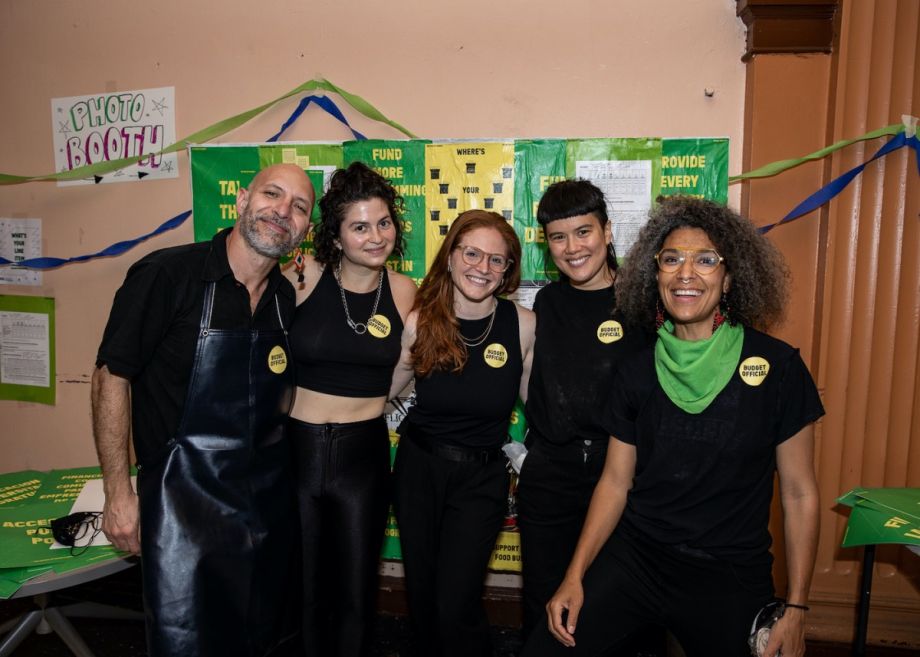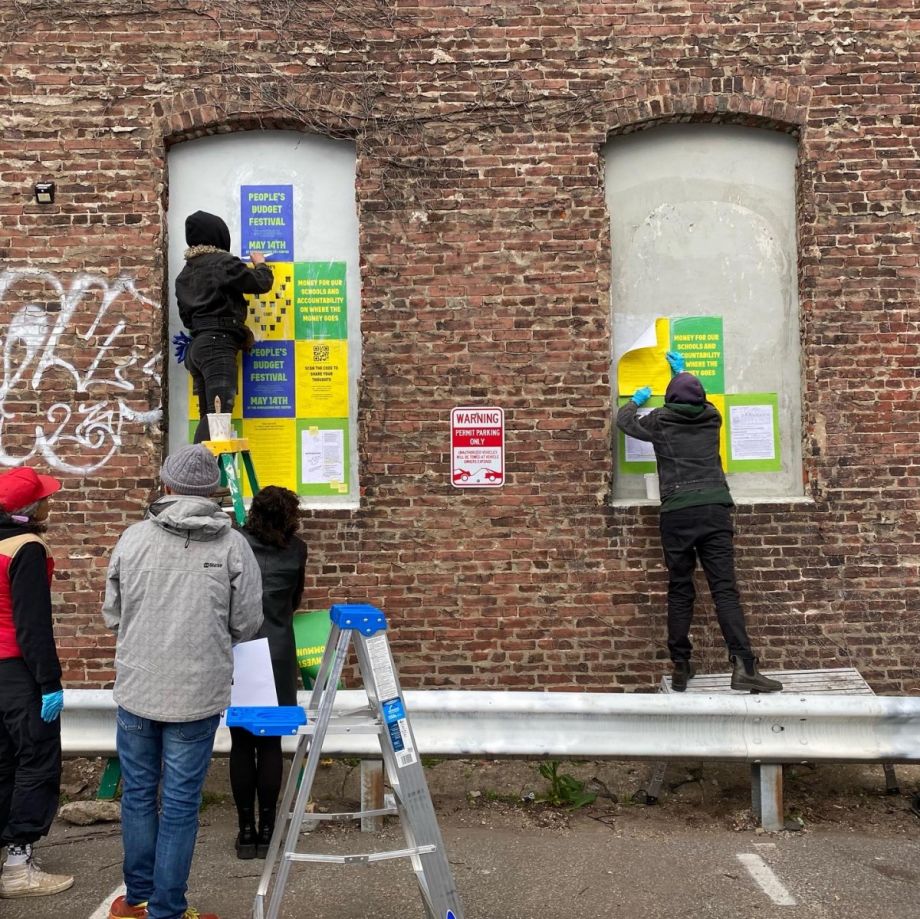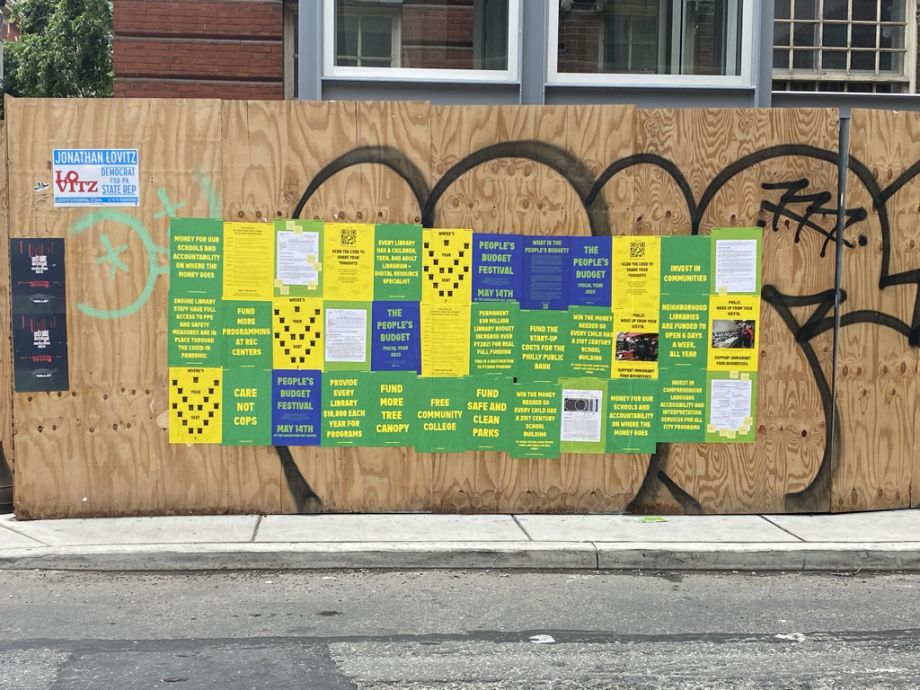Small yellow and green posters have been popping up across Philadelphia over the past year. Pasted on walls and grouped together, they call for change, with messages such as: “Care not cops,” “Fund PHL Arts,” “Invest in Communities” or “Fund Safe and Clean Parks.”
The posters are part of a public art installation, “A People’s Budget” produced by Mural Arts Philadelphia and framed around a simple question: How can art be used to involve community members in reimagining how the city spends its money?
Phoebe Bachman, an artist and the facilitator for this project, says it grew out of conversations sparked by the policing protests in 2020.
“We started talking about what that negotiating process looks like,” she says. “Do you defund, develop or invest more money in the community in other ways for public libraries or educational programming?”
A People’s Budget was created to invite community members to contribute their demands and ideas for a city budget that more accurately reflects the needs of Philadelphians. In 2021, the project installed its first piece of public art and held a series of teach-ins on the city budget. For the project’s second year, however, the group decided to go bigger.
They brought on four local artists in early 2022 — Blanche Brown, Maio Chao, Samantha Rise and Eugenio Salas — to re-envision the city budget through five main themes: how we exchange relationships; protect our city; learn and grow; live in shared spaces; and govern and administer.
The artists then worked collectively to research different sections of the budget through these different perspectives. They familiarized themselves with the budget process and worked with several grassroots organizations and city departments such as the Amistad Law Project, Council Member Kendra Brooks’ office and the Philadelphia Office of Sustainability.

Phoebe Bachman, center, and the four artists who worked on the project (Photo courtesy of Mural Arts)
Written in both English and Spanish, the 30-plus posters have been handed out at events, protests and other gatherings throughout the year. Residents are also invited to submit their own dreams for the city budget that might appear in future printings. The posters are also pasted in over six neighborhoods — including Kensington, Nicetown and West Philly — always put up as a collective mural, rather than focusing on any one cause.
“No single demand is insulated from any other,” says Rise, whose posters focus on the public school system. “A thorough reinvestment in community is going to be reinforcing.”
“We recognize there are many neighborhoods with historic disinvestment in Philadelphia who we must prioritize when it comes to city funding,” Bachman adds, “but it has to be a citywide advocacy effort to work.”
Rise says the posters help to take away the isolation individuals may feel from their lack of participation in the budgetary process and offer some hope by seeing that others also feel detached but that they have possible solutions.
“What we tried to do was leverage the arresting visuals and spaces to stop and savour,” Rise says. “Bring our attention not just to the problems, because we can often shut ourselves down, feeling overwhelmed or helpless when we are confronted with the largeness of the problem.”
The posters have also highlighted how many resources already exist within Philly communities. “I think we undervalue so many of the infrastructure and relationships and kind of experts we have in our communities,” she says.
On May 14, A People’s Budget held a festival at the Kingsessing Rec Center where people came out to discuss their concerns. The local group Mercado de Latinas supplied live translation and free lunches that were served on interactive mats where people could write in their demands for the city budget, do a word unscramble game to understand how the budget works, or even write up their own tax receipt of what the city owes them for what they pay in taxes.
The project comes as a number of cities are having conversations around participatory budgeting. New York City recently expanded a participatory budgeting pilot program, and Philadelphia launched its own pilot project in late 2020 with the intent to spend $1 million on capital projects. Mayor Jim Kenny said in the press release issued at the time that “our budgets must reflect the commitment to creating a more equitable Philadelphia, where race, ethnicity, disability, gender, gender identity, sexual orientation, income or neighborhood are not a determinant of success or life outcome.”

Mural Arts workers paste up posters for a mural (Photo by Phoebe Bachman)
However, Bachman thinks $1 million isn’t enough to have a significant impact. “They would have to do a lot of work to actually get that off the ground and devote a lot more money to it,” she says.
Although A People’s Budget has been focused on community education and engagement, Bachman hopes it does affect the budget. She says some City Council members have been very supportive and other city officials have been surprised but receptive to the ideas reflected on the posters.
“Will [the ideas] actually be incorporated? I don’t know,” she says. “The budget process is always a negotiation. We’re hopeful, and the work is to continue to push year after year. And hopefully, someone is listening.”
If nothing else, Rise says the campaign is sparking important conversations and increasing awareness. It’s also been encouraging for her to see people taking pictures of the public murals and see the posters in people’s windows throughout the city.
“I think part of encouraging people inside of participatory process is the goal of empowerment,” Rise says. “We wanted to offer a framework where people could engage with the budget from a place where it felt accessible and where they felt they had agency not just to say what we need to survive, but more that we deserve to live life richly and fully.”
Connie Aitcheson is a freelance writer based between Florida and Kingston, Jamaica. She worked for many years at Sports Illustrated and has been published in Essence, PTSD Journal, Cosmopolitan and espnw.com.
















